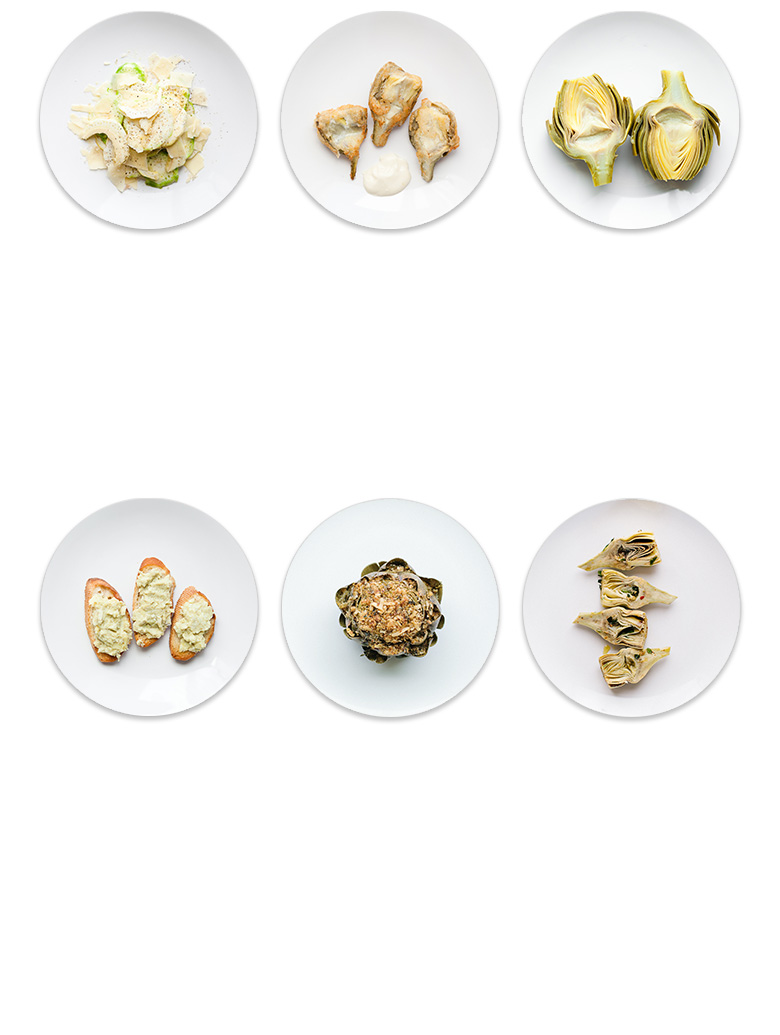

Raw Artichoke Salad
Trim and halve artichokes; remove chokes.
Using a mandoline, thinly slice artichoke hearts.
Toss artichoke slices with olive oil, lemon juice, shaved Parmesan, salt and pepper.
Fried Baby Artichokes
Trim and halve artichokes; soak in buttermilk. Dredge in mixture of equal parts all-purpose and semolina flours.
In deep pan, heat 1 inch of canola oil to 375°F. Fry artichokes until crispy. Drain; serve with aioli.
Braised Artichokes
Trim and halve artichokes; remove chokes.
Cover bottom of baking dish with lemon slices; top with artichokes, salt and pepper. Add chicken stock or white wine to cover artichokes halfway.
Cover with foil. Bake at 400°F until tender.
Artichoke Spread
Trim and halve artichokes; remove chokes. Simmer artichoke hearts until tender.
In food processor, combine artichokes, garlic, lemon juice, olive oil and grated Parmesan; pulse until smooth.
Spread on toasted bread or sandwiches.
Baked Stuffed Artichokes
Trim artichokes; sprinkle with olive oil, salt and pepper. Place in baking dish.
Combine toasted bread crumbs, chopped parsley, grated pecorino, olive oil, minced garlic, lemon zest, salt and pepper. Stuff into center of artichokes and between leaves.
Add 1/2 cup water to pan; cover with foil. Bake at 400°F until tender. Uncover; bake until browned.
Marinated Baby Artichokes
Trim and halve baby artichokes.
Blanch artichokes until tender. Drain well; cool to room temperature.
Place artichokes in jar. Add chopped fresh herbs, garlic, lemon zest and chile flakes; cover with olive oil. Refrigerate and use within 1 week.
Availability
The primary artichoke season is in early spring, followed by a second, smaller season in fall-winter.
Selecting
Buy artichokes that are heavy for their size. Look for tightly closed, olive green leaves and moist, healthy stems. A few purple streaks on the leaves are acceptable, but limp, brownish globes should be passed by. Some winter artichokes have black streaking, which indicates slight frost damage and is nothing to worry about. In fact, some artichoke lovers think these later vegetables are preferable to spring ones for their slightly nutty flavor. Baby artichokes should be olive green with tightly closed leaves.
Preparing
Use only stainless-steel knives and cookware when preparing artichokes, since carbon steel, aluminum and cast iron will discolor the vegetable within moments of cutting. No matter what you do, artichokes will darken somewhat, but fortunately, this discoloration does not affect their flavor. Starting at the base, pull off and discard the tough outer leaves until you reach the tender yellow inner leaves. Cut the stem off flush with the bottom of the leaves. Using a serrated knife, slice off the top 1 to 2 inches of the remaining leaves to remove the thorns. Cut the artichoke in half lengthwise through the center. Using a teaspoon, scrape out the furry choke and drop the halves into a bowl of lemon water.
Storing
Sprinkle artichokes with a few drops of water and store in a perforated plastic bag in the coldest part of the refrigerator for up to 1 week. If cooking them on the day you buy them, leave them at cool room temperature. Once opened, marinated artichoke hearts will keep refrigerated for up to 2 weeks.









